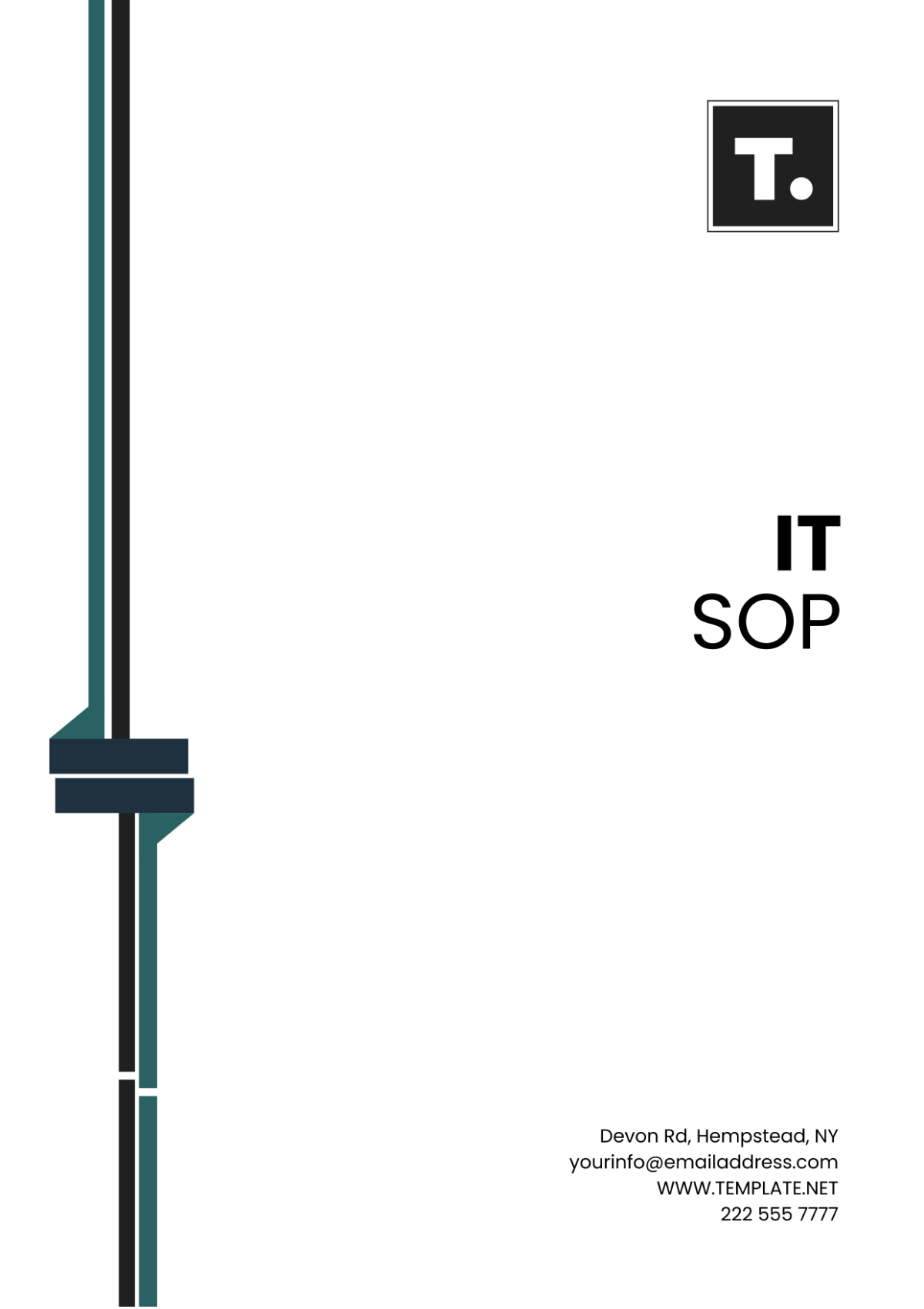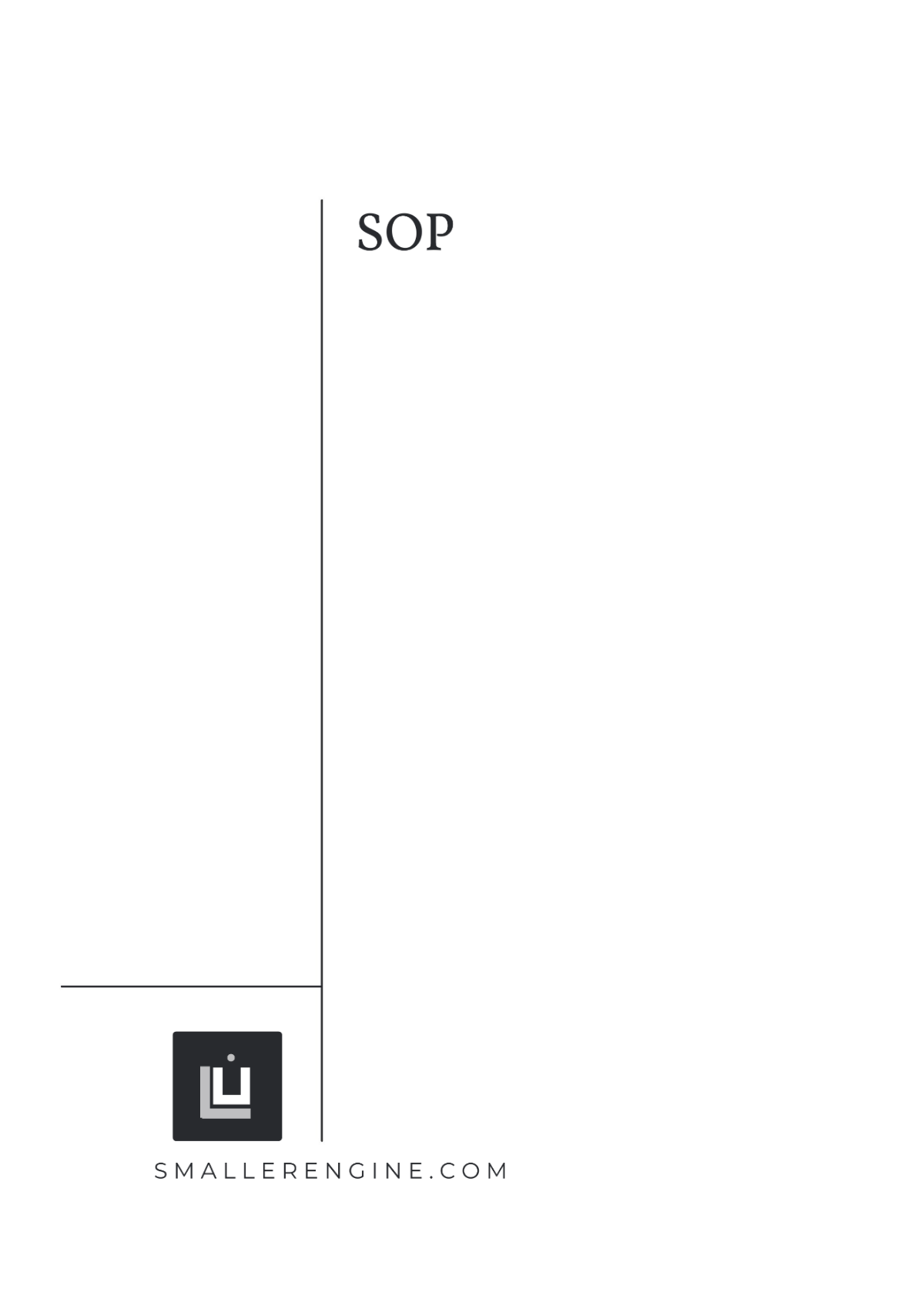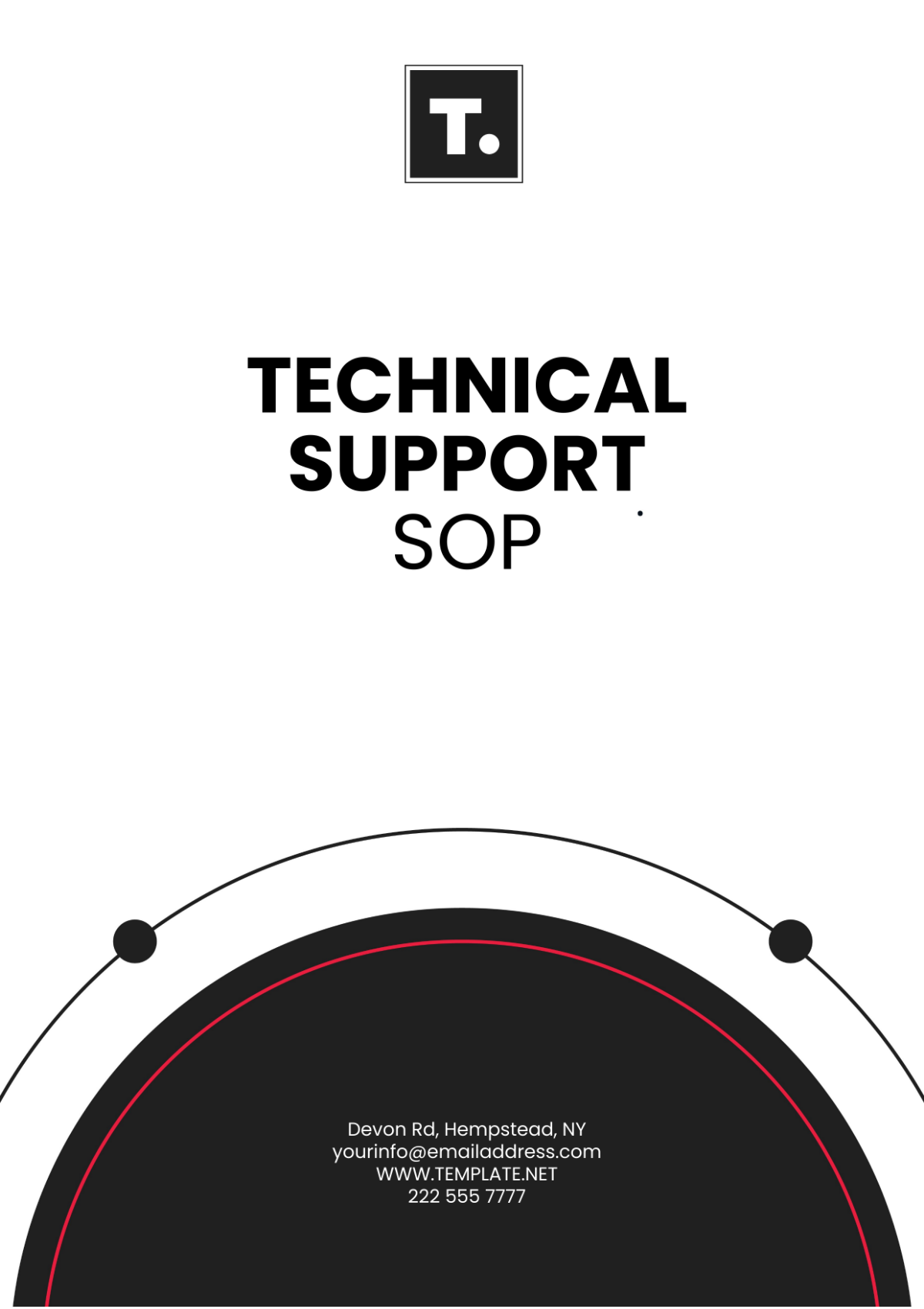Security Service SOP
I. Purpose and Scope
A. Purpose
The purpose of this Standard Operating Procedure (SOP) is to establish clear and comprehensive guidelines for the security services provided by [Your Company Name]. This document outlines the protocols, roles, responsibilities, and procedures necessary for ensuring a safe and secure environment for clients, employees, and assets under protection. It is essential that all personnel adhere to these guidelines to mitigate risks, prevent security breaches, and respond effectively to any security incidents. The SOP aims to cultivate a culture of security awareness, ensuring that all employees understand their roles in maintaining safety.
B. Scope
This SOP applies to all security personnel, contractors, and relevant stakeholders working within or on behalf of [Your Company Name]. It covers all aspects of security operations, including personnel management, threat assessments, emergency response, and the use of security equipment across all premises and projects assigned to the company. The procedures outlined herein are applicable across various operational contexts, including corporate offices, client sites, and remote locations.
II. Security Organization
A. Roles and Responsibilities
Security Manager
The Security Manager is responsible for overseeing all security operations at [Your Company Name]. This includes managing personnel, conducting security assessments, ensuring compliance with legal and industry standards, and acting as the primary contact during emergencies. The Security Manager will review and approve all security-related expenditures, which are estimated to be around $[10,000] annually for training, equipment maintenance, and incident response resources.
The Security Manager must report daily activities, incidents, and recommendations to the executive team. They will also coordinate with law enforcement and other external agencies when necessary, ensuring that communication channels remain open and responsive.
Shift Supervisor
Shift Supervisors are responsible for managing on-duty security personnel. They assign tasks, monitor staff performance, and ensure that all security protocols are followed during their shift. Shift Supervisors are expected to conduct a thorough briefing at the beginning of each shift, lasting at least [15] minutes, to discuss any specific threats or security issues identified during previous shifts.
They also report any incidents to the Security Manager and initiate the first line of response to emergencies. Shift Supervisors will conduct hourly check-ins with security officers to verify that all areas are secure and will regularly update patrol schedules to ensure optimal coverage based on peak hours of activity and threat levels.
Security Officers
Security Officers are tasked with patrolling designated areas, monitoring surveillance equipment, and responding to security breaches or emergencies. They play a critical role in the first line of defense and are expected to maintain a high level of vigilance.
They must log all activities in detailed reports, follow communication protocols, and comply with standard operating procedures outlined by [Your Company Name]. For instance, each officer is required to file a daily activity report that includes at least [5] patrol rounds, noting the time, location, and any unusual observations.
Administrative Support Staff
Administrative staff are responsible for managing security-related documentation, scheduling, and communications within the department. They assist in maintaining records of incidents, staff attendance, and compliance with security policies.
Additionally, they coordinate with human resources to ensure that all security officers have up-to-date training and certifications, including background checks and necessary licensing, which may incur costs of approximately $[1,500] annually per officer.
B. Communication Chain
Incident Reporting
All incidents, whether major or minor, must be immediately reported to the Shift Supervisor, who will assess the situation and escalate to the Security Manager if needed. This includes categorizing incidents into low, medium, and high severity to determine the appropriate response.
The Security Manager will then communicate with executive leadership and external agencies if the situation demands. A standard incident report template will be utilized to ensure all necessary information is collected consistently.
Daily Reports
Security Officers must submit a report at the end of each shift detailing patrol routes, incidents, and any maintenance or equipment needs. This report must be submitted within [30] minutes of the end of the shift and will be compiled by Shift Supervisors into a daily summary for management review.
Shift Supervisors will consolidate these reports into a daily summary and forward it to the Security Manager for review, ensuring that patterns or recurring issues can be identified and addressed proactively.
III. Risk Assessment and Threat Management
A. Identifying Threats
[Your Company Name] utilizes a proactive approach to identify and assess threats to personnel, property, and data. Potential threats include:
Internal Threats
Unauthorized access by employees can lead to theft of sensitive information or resources. An example includes a former employee attempting to access confidential files post-termination, which necessitates strict access control measures.
Theft or sabotage by insiders is a significant risk, especially in environments where sensitive equipment is stored. The loss of equipment, for instance, can cost the company upwards of $[5,000] depending on the asset.
Breaches in data security by internal personnel can lead to compliance violations, potential fines, and loss of client trust.
External Threats
Intrusions or unauthorized access by outsiders pose a constant risk, particularly in facilities that lack adequate perimeter security. Regular assessments of perimeter defenses should be conducted quarterly.
Cybersecurity attacks or phishing schemes can compromise sensitive data. Recent industry statistics show that businesses may incur costs averaging $[200,000] per data breach in remediation efforts.
Vandalism, theft, or property damage can disrupt operations and incur repair costs. A single incident of vandalism can result in costs ranging from $[1,000] to $[10,000] depending on the extent of damage.
B. Threat Levels
Low-Level Threats
Incidents such as a minor theft, unauthorized access without malicious intent, or suspicious activity that does not immediately endanger personnel or assets require monitoring but not immediate action.
For instance, an unattended bag left in a lobby might be classified as a low-level threat, prompting an investigation without alarm.
Medium-Level Threats
Incidents such as break-ins, theft of sensitive equipment, or vandalism that may have a significant impact on the safety of personnel or security of assets require immediate response by security personnel.
An example includes unauthorized access during off-hours, which could indicate potential criminal intent and should prompt a thorough investigation.
High-Level Threats
Events involving physical danger to individuals or large-scale attacks, such as terrorism, armed intrusion, or cyber-attacks that compromise critical systems, demand immediate and coordinated responses, including law enforcement and emergency services involvement.
For example, a report of an armed individual on the premises necessitates instant action, including lockdown procedures, communication with local law enforcement, and detailed coordination of personnel to manage the situation safely.
C. Mitigating Threats
Physical Security Measures
The use of barriers, locks, surveillance cameras, and alarm systems at all vulnerable access points. For instance, the installation of a new access control system may require an investment of approximately $[15,000], including labor and equipment costs.
Security personnel will regularly inspect these systems to ensure functionality, conducting checks at least once per week and documenting any discrepancies.
Digital Security
Firewalls, intrusion detection systems, and encrypted communications are utilized to protect data and internal communications. A dedicated cybersecurity team will monitor network activities and report suspicious behavior to the Security Manager.
The estimated annual cost of maintaining cybersecurity measures, including software licenses and hardware, is around $[20,000].
Training and Drills
All personnel will undergo quarterly security training sessions to remain up-to-date on potential threats and proper response protocols. Each session will last approximately [2] hours and include scenario-based training to enhance understanding.
Regular drills for emergency evacuation, lockdown, and cyber breach scenarios will be conducted semi-annually to ensure all personnel can react appropriately during real emergencies.
IV. Security Equipment and Technology
A. Surveillance Systems
Closed-Circuit Television (CCTV)
CCTV systems are installed in all high-risk areas to monitor activities and deter potential criminal behavior. The footage will be stored for a minimum of [90] days and reviewed as part of incident investigations. Each camera system installation is estimated to cost around $[5,000], including hardware and installation services.
Security personnel will review footage weekly to identify any suspicious activities or patterns that may require further investigation.
Motion Detectors and Sensors
Motion detectors are strategically placed in less monitored areas to detect unauthorized movement. Any detected motion outside normal operational hours will trigger an alert to security personnel and will be logged for follow-up.
The installation of motion detectors is projected to cost approximately $[2,500] per facility, ensuring enhanced security across vulnerable entry points.
B. Access Control Systems
ID Card Readers
All employees and authorized visitors will be issued identification cards with access control features. These cards are necessary for entry into restricted areas and will cost around $[10] per card, including the card reader system.
Access logs will be reviewed weekly to identify any unauthorized or unusual entries, with security personnel conducting audits to ensure compliance.
Biometric Scanners
Biometric authentication, including fingerprint and facial recognition systems, will be used at highly sensitive areas to ensure only authorized personnel gain access. The implementation of biometric systems is expected to incur costs of around $[15,000], considering installation and hardware.
These systems will be regularly maintained to ensure functionality and will be integrated into the overall security infrastructure of [Your Company Name].
C. Communication Systems
Radio Communication
All security personnel will be equipped with two-way radios to ensure constant communication, particularly during emergencies. The estimated cost for the radio equipment is around $[500] per unit.
Training on the effective use of these communication systems will be included in the initial onboarding process for new hires.
Emergency Notification Systems
An emergency notification system will be implemented to alert all personnel of critical incidents, ensuring rapid response. This system will send alerts via email, text message, and app notifications. The implementation cost is projected at $[10,000].
Regular tests of the notification system will be conducted to ensure its effectiveness and to familiarize staff with its operation.
V. Emergency Response Procedures
A. Incident Response
Immediate Actions
Upon discovery of an incident, the first responding officer will assess the situation to determine the severity and required response. For instance, in the case of a fire alarm activation, the officer will ensure all personnel evacuate the building promptly, following established evacuation protocols.
Security personnel will maintain communication with the Shift Supervisor and follow instructions regarding further actions, such as contacting emergency services or initiating lockdown procedures.
Documentation of Incidents
Every incident must be documented using the standardized Incident Report Template (Appendix A), including time, location, individuals involved, and actions taken. This documentation is critical for later reviews and potential legal processes.
Reports must be submitted to the Shift Supervisor within [24] hours of the incident for review and follow-up actions.
B. Evacuation Procedures
Evacuation Plans
Detailed evacuation plans will be displayed throughout the facility, with clear signage indicating exits and safe zones. Regular drills will be conducted to familiarize personnel with these procedures.
Each department will conduct bi-annual evacuation drills, documenting participation and feedback for continuous improvement.
Roll Call Procedures
After evacuation, a roll call will be conducted at a predetermined safe location to account for all personnel. Any missing individuals will be reported immediately to emergency services for further assistance.
Security Officers will be trained to recognize the importance of accurate accounting, as failure to do so can hinder rescue operations.
C. Response to Violent Incidents
Active Shooter Protocol
In the event of an active shooter, personnel will be trained to follow the “Run, Hide, Fight” protocol. Specific training sessions will be provided to prepare employees for this critical situation.
Security Officers will be trained to take immediate action to secure the area and assist law enforcement upon their arrival.
Incident Debriefing
Following any significant incident, a debriefing session will be held to analyze responses, discuss what worked well, and identify areas for improvement. These sessions will involve all relevant personnel, including management and operational staff, to foster a culture of continuous learning.
Documentation from these sessions will be reviewed during the annual SOP review to ensure updates and improvements to the emergency response protocols.
VI. Reporting and Documentation
A. Incident Reporting
Report Submission
All incident reports must be submitted to the Shift Supervisor within [24] hours of the incident. The Shift Supervisor will review the report for completeness before forwarding it to the Security Manager for further action.
Timeliness and accuracy in report submission are critical to ensuring effective follow-up and mitigation of similar incidents in the future.
Incident Review Meetings
Monthly meetings will be held to review all incidents reported during the month, allowing for open discussion and collective learning among security personnel. Key metrics, such as the number of incidents, response times, and follow-up actions, will be analyzed for trends.
These meetings will foster collaboration and ensure that best practices are shared across shifts and personnel levels.
B. Record Keeping
Documentation Storage
All incident reports, training records, and compliance documents will be stored electronically in a secure database accessible only to authorized personnel. This will ensure confidentiality while allowing for easy retrieval when needed.
A dedicated administrative staff member will be assigned to manage this database, performing quarterly audits to ensure all records are complete and up-to-date.
Retention Policy
Incident reports and other critical documents will be retained for a minimum of five years, while training records will be maintained indefinitely. This ensures that the company has a thorough history of incidents and training efforts for compliance and reference purposes.
A clear policy regarding document retention will be communicated to all staff to ensure adherence.
VII. Health and Safety Policies
A. General Safety Practices
Workplace Safety
Security personnel must be trained to recognize and report unsafe conditions. Regular safety audits will be conducted, and corrective measures will be taken promptly. For example, a safety audit may identify areas where proper lighting is needed, requiring immediate upgrades costing an estimated $[3,000].
Safety gear, such as reflective vests, hard hats, and gloves, must be worn during specific tasks, particularly when dealing with emergencies or hazardous materials. The estimated cost for safety gear per officer is approximately $[200] annually.
Ergonomics and Health
Security staff are encouraged to maintain good ergonomic practices while performing tasks, especially those involving extended periods of surveillance or report writing. Training will be provided on proper body mechanics to minimize the risk of injury, potentially saving costs associated with worker’s compensation claims averaging $[10,000] per incident.
Regular breaks will be mandated for security personnel working long shifts to ensure alertness and reduce fatigue. Shift schedules will include mandatory breaks of at least [15] minutes every [4] hours.
B. Personal Health Standards
Health Screenings
Regular health screenings will be offered to all security personnel to monitor and promote well-being. The company will provide annual screenings at an estimated cost of $[100] per employee. Any personnel showing symptoms of illness must report to the Shift Supervisor and may be sent home to prevent the spread of illness.
Personnel will be encouraged to maintain healthy lifestyles, and initiatives such as wellness programs or gym memberships may be offered.
Mental Health Support
[Your Company Name] acknowledges the high-stress nature of security work and will provide access to mental health resources. This includes access to counseling services and stress management workshops. Estimated costs for these services may be around $[5,000] annually.
Security personnel will be encouraged to participate in mental health training to identify signs of distress in themselves and their colleagues, fostering a supportive environment. Peer support groups may also be established to provide a platform for discussing challenges.
VIII. Equipment Maintenance and Inventory
A. Routine Equipment Inspections
Inspection Schedule
All security equipment, including cameras, alarms, and communication devices, will undergo scheduled inspections. Inspections will be conducted bi-weekly and documented for accountability. Each inspection may take approximately [1] hour, during which all equipment will be tested for functionality.
Any equipment deemed malfunctioning or in need of repair will be flagged for immediate attention and will not be returned to service until repaired or replaced.
Maintenance Records
Maintenance records will be kept for all security equipment, detailing inspection dates, repairs conducted, and any replacements made. The records will be updated in real-time and reviewed quarterly to identify trends in equipment failure and inform purchasing decisions for future upgrades.
Estimated costs for maintenance may average around $[2,000] annually, depending on equipment wear and tear.
B. Inventory Management
Inventory Tracking
An inventory management system will be implemented to track all security equipment, including serial numbers, purchase dates, and maintenance history. A software solution may be utilized, costing approximately $[3,000] for initial setup and training.
Monthly inventory checks will ensure all items are accounted for, and discrepancies will be investigated immediately. A checklist will be developed to streamline this process.
Equipment Disposal
Proper procedures for disposing of obsolete or damaged equipment will be established to ensure compliance with environmental regulations. Any disposal of electronic equipment will follow established e-waste protocols, which may incur additional costs of around $[1,500] annually for disposal services.
Documentation will be maintained for all disposals to ensure transparency and accountability.
IX. Review and Revision of SOP
A. Annual Review Process
SOP Review
This SOP will be reviewed annually to ensure its effectiveness and relevance. Any changes in regulations, technology, or company policy will prompt a review of this document. During the review process, all personnel will be encouraged to provide feedback on the SOP based on their experiences.
Feedback from security personnel regarding the SOP will be gathered through surveys and discussions during team meetings. The anticipated costs of implementing changes based on feedback may be around $[2,000] for training and materials.
Revision Documentation
Any revisions made to the SOP will be documented, including the date of revision and the nature of changes. Updated versions will be disseminated to all staff, and a summary of changes will be highlighted for easy reference.
A dedicated section in the SOP will be maintained to list all changes for historical purposes, aiding in understanding the evolution of security practices within [Your Company Name].
B. Training on Revised Procedures
Re-training Requirement
When significant changes to the SOP occur, all relevant personnel will undergo re-training sessions to ensure compliance with the updated procedures. Training sessions will be scheduled within [30] days of the revisions being finalized.
New training materials reflecting the revisions will be distributed to staff, with estimated costs of $[1,000] for printing and materials.
Evaluation of Understanding
Following training on revisions, personnel will complete an evaluation to demonstrate their understanding of the changes made to the SOP. This evaluation will help identify any areas that may require additional training or clarification.
A review of evaluation results will be conducted, and necessary follow-up training will be scheduled within [60] days of evaluation completion.

















































